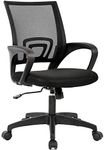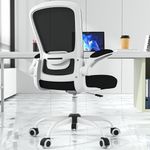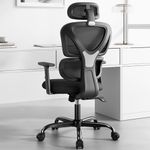Buying Guide for the Best Ergonomic Office Chairs
Choosing an ergonomic office chair is all about finding a seat that supports your body during long hours of work, helps maintain good posture, and reduces discomfort or strain. The right chair can make a big difference in your daily comfort and productivity. When shopping, focus on how the chair adjusts to your body, the support it offers, and the materials used. Think about how much time you spend sitting, your body shape, and any specific needs like back pain or mobility. Testing a chair in person is ideal, but if shopping online, pay close attention to the specifications and user reviews.AdjustabilityAdjustability refers to how many parts of the chair you can change to fit your body, such as seat height, armrest position, backrest tilt, and lumbar support. This is important because everyone’s body is different, and a chair that adjusts in multiple ways can better support your unique shape and sitting habits. Some chairs offer only basic height adjustment, while others let you fine-tune almost every part. If you spend many hours at your desk or share the chair with others, look for a model with more adjustability. If your needs are simple or you sit for short periods, basic adjustments may be enough.
Lumbar SupportLumbar support is the part of the chair that supports your lower back. Good lumbar support helps maintain the natural curve of your spine and prevents slouching, which can lead to back pain. Some chairs have fixed lumbar support, while others let you adjust the height or depth. If you have a history of back pain or want to prevent it, look for adjustable lumbar support. If your back feels fine and you sit for short periods, fixed support may be sufficient.
Seat Depth and WidthSeat depth and width determine how well the chair fits your body. A seat that’s too short may not support your thighs, while one that’s too deep can put pressure on the back of your knees. Most people do well with a seat that allows them to sit back comfortably with a few inches between the edge of the seat and their knees. Some chairs let you adjust the seat depth, which is helpful if you’re taller or shorter than average. Consider your body size and whether you need extra room or a more compact seat.
Material and BreathabilityThe material of the chair affects comfort, durability, and how much heat builds up while you sit. Mesh chairs are popular for their breathability, keeping you cool during long hours. Fabric and leather (real or synthetic) offer a different feel and may be more cushioned, but can get warmer. If you tend to get hot or work in a warm environment, mesh is a good choice. If you prefer a softer or more traditional look, consider fabric or leather, but be aware of how it might feel after hours of use.
ArmrestsArmrests support your arms and help reduce strain on your shoulders and neck. Some chairs have fixed armrests, while others let you adjust the height, width, or angle. Adjustable armrests are helpful if you type a lot or need to move your chair close to your desk. If you don’t use armrests much or have a small workspace, fixed or removable armrests may be fine. Think about how you work and whether you need extra support for your arms.
Swivel and MobilitySwivel and mobility refer to how easily the chair turns and moves around. Most office chairs have wheels and a swivel base, making it easy to reach different parts of your desk without straining. If you work at a large desk or need to move frequently, smooth-rolling wheels and a good swivel are important. If your workspace is small or you don’t move much, this may be less of a priority.
Weight CapacityWeight capacity is the maximum weight the chair is designed to support safely. This is important for safety and durability. Chairs are usually rated for a range of weights, and it’s best to choose one that comfortably supports your body weight. If you’re heavier or want extra peace of mind, look for a chair with a higher weight capacity.


















